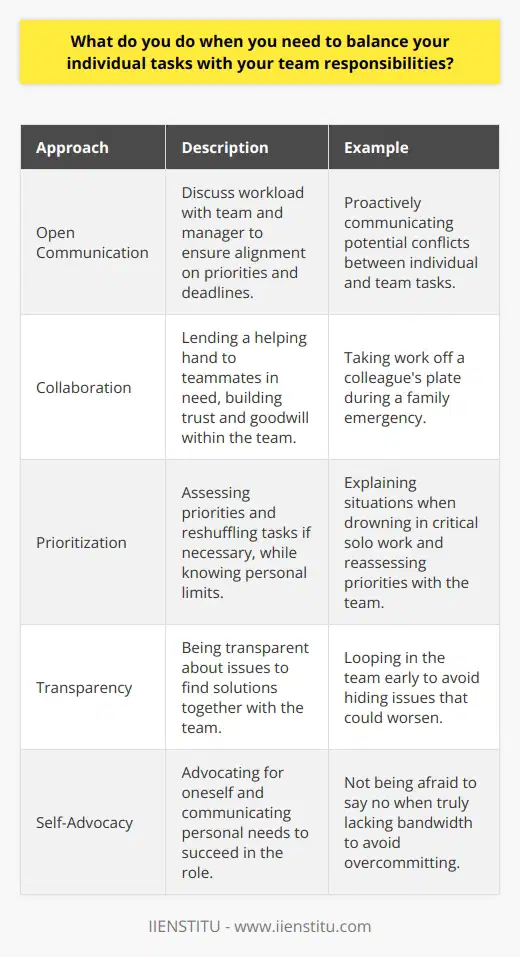
Looking to the heart of this potentially tricky interview question, we find hiring managers eager to shed light on the coping strategies of potential hires when faced with managing time and meeting project deadlines.
In the fast-paced work arena, time management is vital to ensuring efficiency and productivity. Similarly, balancing one's work-life elements is also pivotal to long-term career sustainability.
Related Course: Time Management Course Online
Thus, "how do you set time management boundaries at work?" directs an unwavering spotlight on your capacity for striking this balance.
Purpose of the Question: How do you set time management boundaries at work?
Multiple motivations indeed lie behind the inquiry. Primarily, it aids global comprehension of your prioritising approach and how effectively you handle and allocate time towards work tasks, amidst any distractions.
Additionally, it illuminates your personal attitudes toward work-life balance, a core concern for any futuristic, human-focused organisation cognisant of employee well-being's key role in overall productivity.
At What Interview Level Is It Asked?
This poser is usually broached at the intermediate or advanced interview level, especially for managerial or senior positions responsible for controlling numerous tasks simultaneously, meeting stiff deadlines, and maintaining equilibrium between professional and personal lives.
Interview Question: How Do You Handle Time Management Interruptions?
Interview Question: Which Time Management Tool Do You Rely On Most?
What Kind of Answer is Expected from the Candidate?
Your response must portray you not just as an adept time juggler, but one appreciative of the need for protective boundaries differentiating work and personal time.
A detailed yet succinct answer incorporating proven strategies for effective time management, complete with instances from your career where such tactics yielded positive results, would hit the mark.
Possible Answers to Consider
An ideal response could be:
"I understand that setting time management boundaries at work aids in maintaining efficiency and enhancing productivity. I accomplish this through a variety of strategies.
Firstly, I make judicious use of productivity tools like task management applications to organise and streamline my tasks.
Secondly, I begin my day by crafting a priority-based work schedule. I then adhere strictly to this schedule, incorporating breaks to ensure I don't overwork and thus remain focused. I also maintain a flexible attitude, reassessing my schedule as required throughout the day to address unpredictable work exigencies.
Additionally, I have established the habit of not bringing work home to guard my personal time, creating a clear demarcation between my work and life outside work.
In my previous role as a Project Manager, I led my team to successfully deliver several projects ahead of schedule, testifying to the efficiency of my time management strategies."
When moving to answer, "how do you set time management boundaries at work," remember interviewers are out to discover more about your working style.
Leverage this opportunity to emphasise your ability to efficiently manage your responsibilities and demonstrate your commitment to a healthy work-life balance.
Every query hurled at you in an interview serves as a window through which potential employers peek into your professional mettle. Understand the essence of each question and prepare your responses accordingly.
Remember, genuinely insightful answers impress far more than overly rehearsed, jargon-laden ones. And the golden rule remains: stay honest, imbibe clarity, and exude confidence. Good luck with setting those time boundaries!
Strategies for Setting Time Management Boundaries at Work
Comprehensive Discussion on Time Management Boundaries
Outcomes of Effective Time Management Boundaries at Work
Similar interview questions:
What methods do you use to establish time management limits at your job?
Can you provide tips on setting up efficient time management boundaries in a professional setting?
How can an individual apply effective time management borders at work?
What strategies do you recommend for devising time management restrictions in the workplace?
What advice could you give about enforcing time management boundaries at work?
How would you illustrate setting time management boundaries effectively in an office environment?
Could you suggest ways of implementing time management boundaries for better productivity at work?
What are your guidelines for creating efficient time management limitations during work hours?
Can you shed some light on implementing operational time management boundaries in a work scenario?
How would you guide someone to build robust time management boundaries at their workplace?
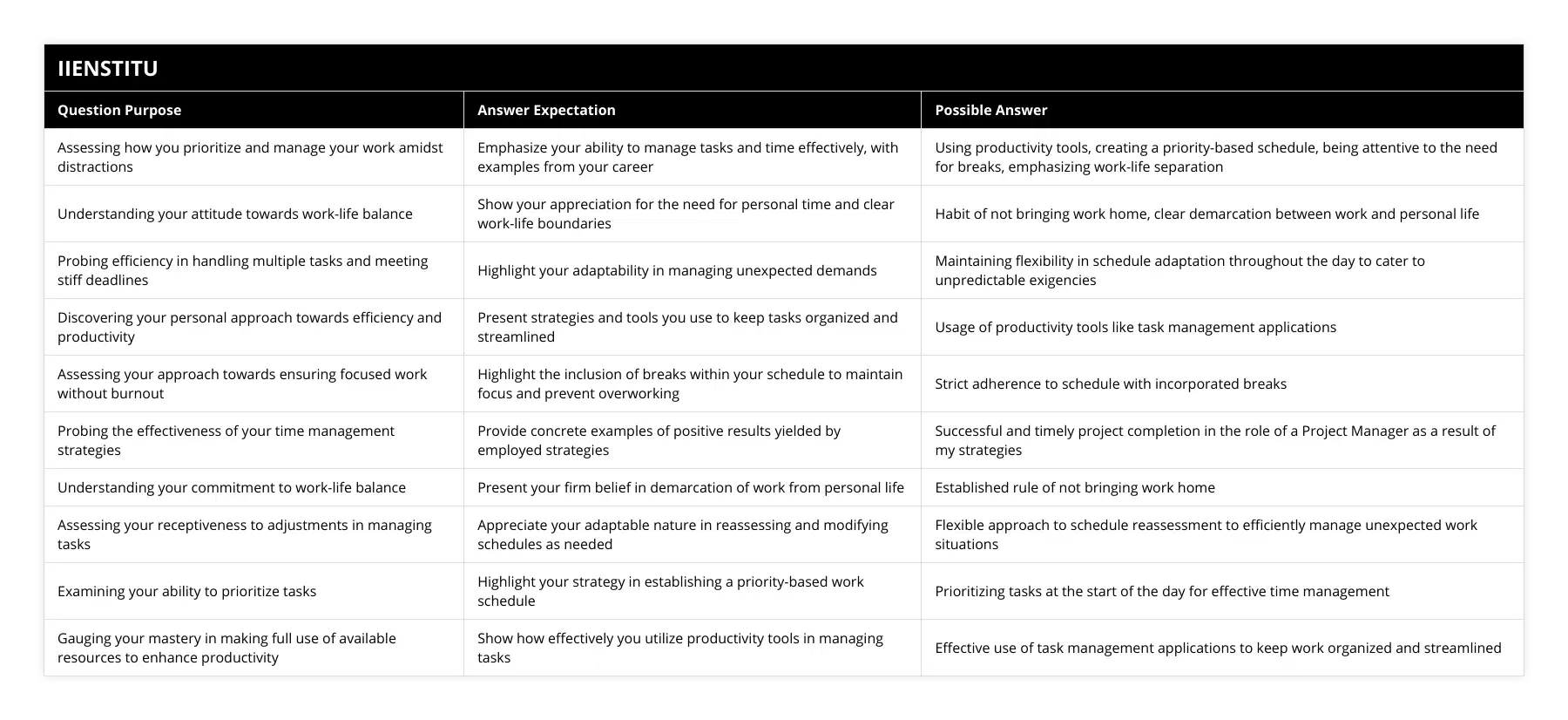
Frequently Asked Questions
How do you prioritize your tasks and manage your workload?
When it comes to prioritizing tasks and managing my workload, I have a few strategies that work well for me:
Make a To-Do List
I start each day by making a to-do list. I jot down all the tasks I need to accomplish, big and small. It helps me visualize what needs to get done and feel more in control.
Prioritize Based on Urgency and Importance
Once I have my list, I prioritize the tasks based on their urgency and importance. I ask myself, "What absolutely must get done today?" Those items go at the top of my list.
Then I look at the important but less urgent tasks. I try to carve out time for those too, even if it's just a little progress each day.
Break Big Tasks into Smaller Steps
When I have a large, daunting project, I break it down into smaller, manageable steps. This makes it feel less overwhelming and helps me stay motivated.
I set mini-deadlines for each step to keep myself on track. Crossing off those small victories keeps me energized!
Stay Flexible and Adapt
Of course, unexpected things pop up all the time. A client calls with an urgent request, a colleague needs help with something...
When that happens, I try to stay flexible and adapt my plan as needed. I communicate with my team and reprioritize as a group.
Take Breaks and Avoid Burnout
Finally, I've learned the importance of taking breaks and avoiding burnout. When I feel myself getting frazzled or losing focus, I step away for a few minutes.
I'll take a quick walk, do some stretches, or chat with a coworker. Those little moments help me recharge and tackle my to-do list with fresh energy.
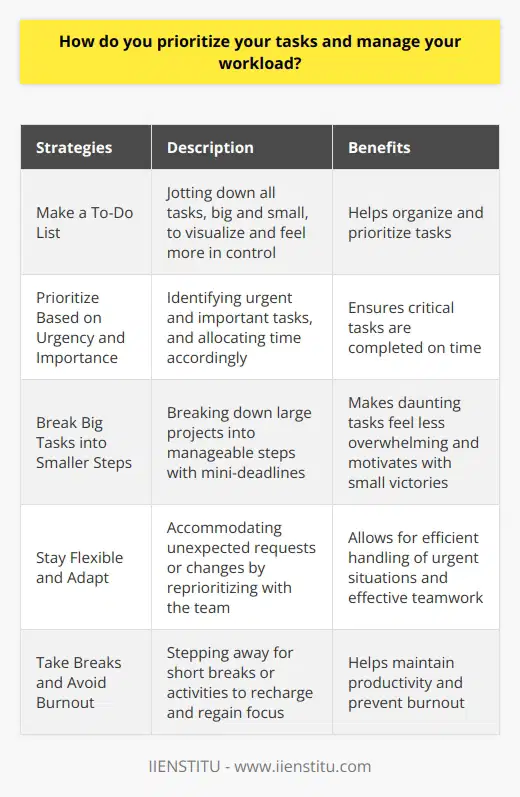
What strategies do you use to avoid distractions and stay focused on your work?
To stay focused and avoid distractions, I employ several strategies that have proven effective for me. First, I prioritize my tasks and create a daily to-do list to keep myself organized and on track.
Minimizing Distractions
I minimize potential distractions by silencing my phone notifications and closing unnecessary browser tabs. When working on important projects, I find a quiet workspace away from chatty coworkers and noisy environments.
Time Blocking
Another strategy I use is time blocking - dedicating specific chunks of time to focus intensely on one task. I set a timer, usually for 25-50 minutes, and work without interruption until the timer goes off. Then I take a short break before starting the next focused work block.
Benefits of Time Blocking
Time blocking helps me stay in a state of deep concentration and avoid context switching, which can be a huge productivity killer. I've found that by fully immersing myself in one task at a time, I'm able to make significant progress much more quickly than if I try to juggle multiple things at once.
Productive Breaks
When I do take breaks, I make sure they are genuinely refreshing and re-energizing. I'll step away from my desk, do some light stretching, grab a healthy snack, or chat briefly with a colleague. This helps me return to my work with renewed focus and a clear mind.
Staying Motivated
Ultimately, I stay focused by keeping my bigger goals and purpose in mind. When I feel my concentration starting to slip, I remind myself why the work I'm doing matters. Knowing that my efforts are contributing to something meaningful gives me the drive to push through distractions and give my full attention to the task at hand.
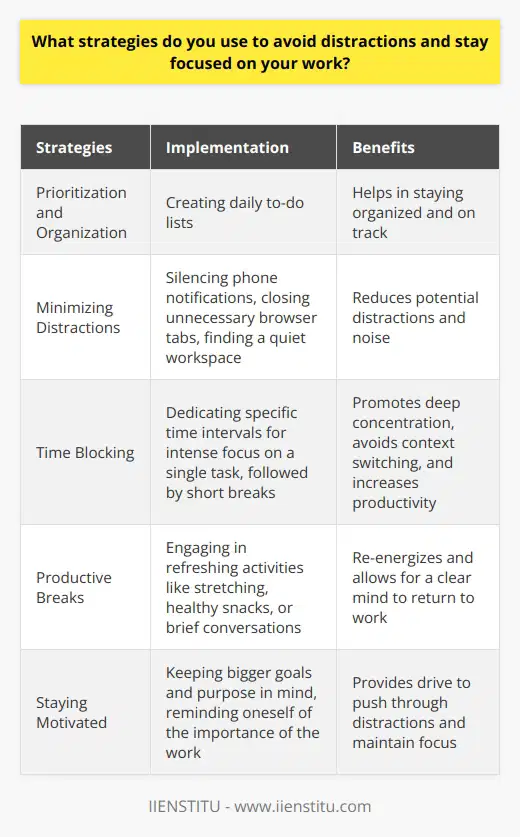
How do you handle multiple deadlines and competing priorities?
I've developed a system to effectively manage multiple deadlines and competing priorities. Here are some key strategies I employ:
Prioritize and Plan
I start by assessing the urgency and importance of each task. I then create a prioritized to-do list, focusing on the most critical items first. Breaking larger projects into smaller, manageable steps helps me stay organized and on track.
Communicate and Collaborate
Open communication is essential when juggling multiple responsibilities. I keep my team and stakeholders informed about my progress, potential challenges, and any adjustments to the timeline. Collaborating with colleagues allows us to share the workload and support each other.
Stay Flexible and Adaptable
In fast-paced environments, priorities can shift unexpectedly. I remain flexible and ready to adapt my plans as needed. If a new urgent task arises, I quickly reassess my priorities and make necessary adjustments to ensure all deadlines are met.
Utilize Time Management Techniques
I leverage various time management techniques to maximize my productivity. The Pomodoro Technique helps me stay focused by working in concentrated intervals with short breaks in between. I also block off dedicated time for specific tasks to minimize distractions and ensure progress.
Practice Self-Care
Managing multiple deadlines can be stressful, so I prioritize self-care to maintain my well-being and performance. I take regular breaks, practice mindfulness, and engage in activities that help me recharge. A clear mind and a healthy body enable me to tackle challenges more effectively.
By implementing these strategies, I've successfully handled numerous concurrent projects and deadlines throughout my career. I'm confident in my ability to thrive in dynamic, fast-paced environments while consistently delivering high-quality results.
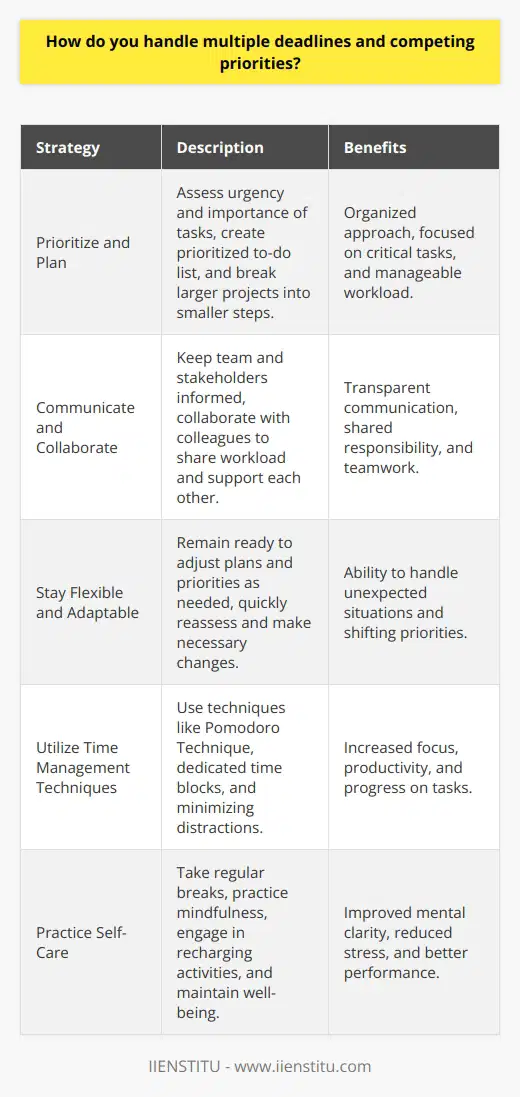
What do you do when you feel overwhelmed with your workload?
When I feel overwhelmed with my workload, I take a step back and prioritize my tasks. I find that breaking down larger projects into smaller, manageable steps helps me feel more in control and less stressed.
Communicate with Your Team
I also make sure to communicate with my team and my supervisor about my workload. If I'm feeling swamped, I'll reach out and see if anyone has the capacity to help out or if we can shift some deadlines around. It's important to be honest and proactive when you're feeling overwhelmed.
Take Breaks and Practice Self-Care
Another thing I do when I'm feeling overwhelmed is to make sure I'm taking breaks and practicing self-care. Even just a few minutes of deep breathing or a quick walk around the block can help me clear my head and refocus.
Stay Organized and Focused
Staying organized is key when you're dealing with a heavy workload. I use tools like calendars, to-do lists, and project management software to keep track of everything on my plate. It helps me stay focused and ensures that nothing falls through the cracks.
Learn from the Experience
Finally, I try to learn from the experience of being overwhelmed. I reflect on what worked well and what didn't, and I use that knowledge to improve my processes and prevent similar situations in the future. It's all about continuous improvement and growth.
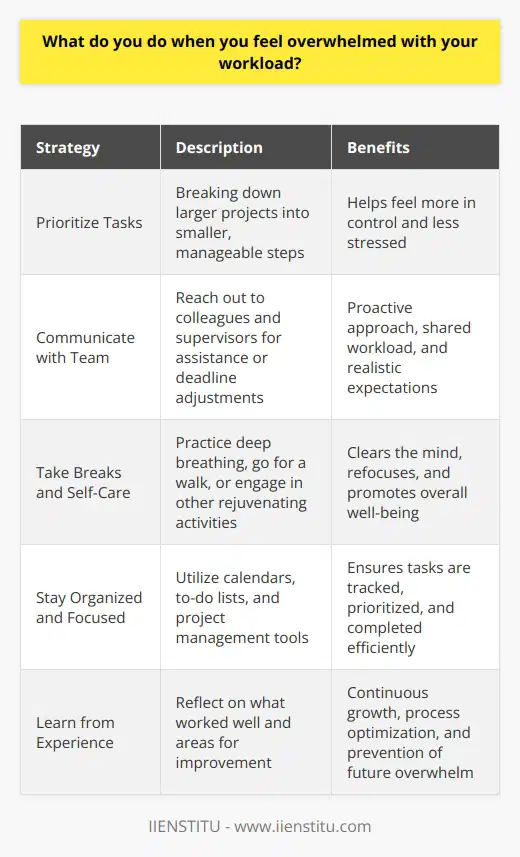
How do you ensure that you are using your time efficiently at work?
I ensure that I'm using my time efficiently at work by prioritizing my tasks and setting realistic goals. Every morning, I create a to-do list and rank each item based on its importance and urgency. This helps me focus on the most critical tasks first and avoid getting sidetracked by less important ones.
Effective Time Management Strategies
Another strategy I use is breaking down large projects into smaller, manageable steps. By doing this, I can make steady progress without feeling overwhelmed. I also set aside dedicated blocks of time for specific tasks, which helps me stay focused and avoid multitasking, which can actually decrease productivity.
Minimizing Distractions
To minimize distractions, I turn off notifications on my phone and computer when working on important tasks. If I'm working on a project that requires deep concentration, I'll even put on noise-canceling headphones to block out background noise.
Collaborating with Colleagues
I also believe in the power of collaboration. When I'm stuck on a problem or feeling overwhelmed, I reach out to my colleagues for help and advice. By working together, we can often find solutions more quickly than if I were trying to tackle the issue alone.
Continuous Improvement
Finally, I'm always looking for ways to improve my time management skills. I regularly reflect on my work habits and try to identify areas where I can be more efficient. I'm not perfect, but I'm committed to learning and growing so that I can make the most of my time at work.
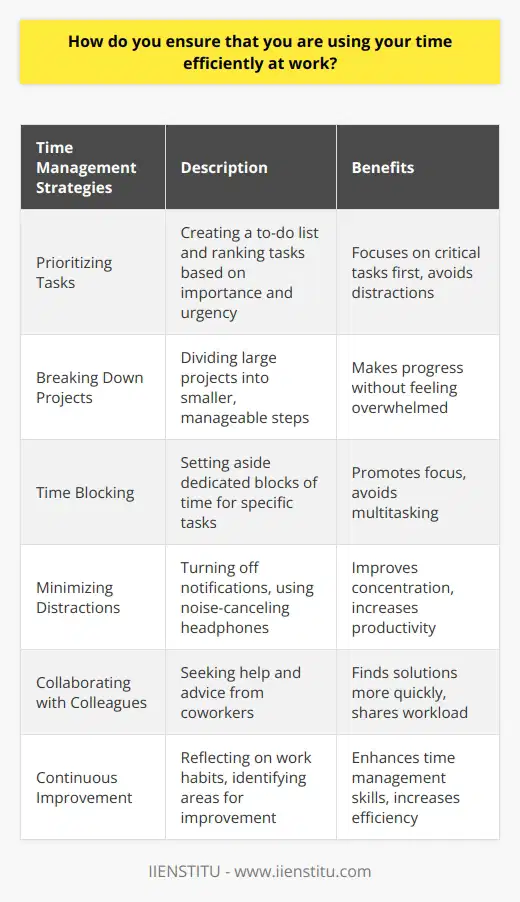
What techniques do you use to estimate the time required for each task?
When estimating the time required for each task, I rely on a combination of techniques. First, I break down the task into smaller, manageable subtasks. This allows me to analyze each component and identify potential roadblocks or complexities.
Drawing from Experience
I draw from my past experiences working on similar projects. While no two tasks are exactly alike, I can often find parallels that help me gauge the time required. For example, when I was working on a website redesign last year, I encountered unexpected compatibility issues that added a few days to the timeline. Knowing this, I now budget extra time for testing and troubleshooting.
Consulting with Colleagues
I also consult with colleagues who have worked on comparable assignments. Their insights and lessons learned are invaluable in creating realistic estimates. Just last week, I reached out to a teammate who had recently completed a data migration project similar to one on my plate. Her advice helped me anticipate some data cleansing challenges and adjust my timeline accordingly.
Building in Buffers
Finally, I always build in buffers for unexpected delays or pivots. No matter how well I plan, there are always variables outside my control. By adding a 10-15% buffer to my estimates, I can absorb small hiccups without derailing the entire project.
At the end of the day, estimating time is a blend of art and science. By combining hard data with professional intuition, I'm able to craft reliable projections while remaining adaptable to change.
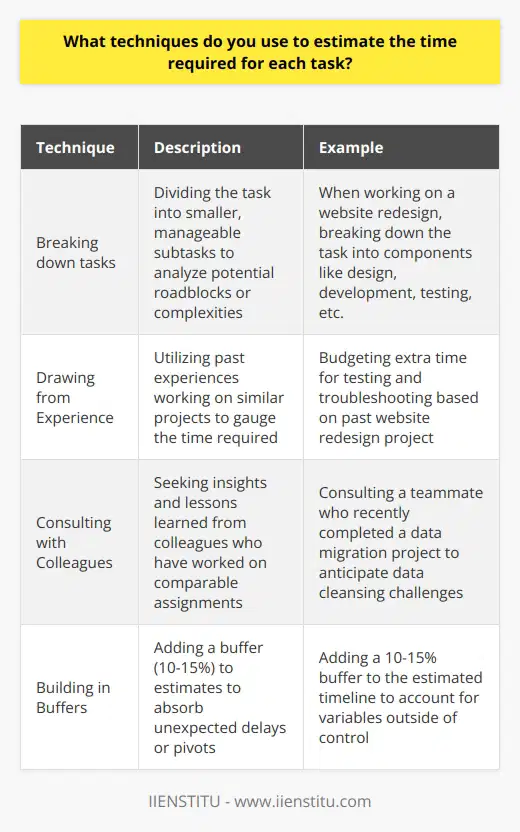
How do you handle interruptions and unexpected tasks that arise during the workday?
When unexpected tasks or interruptions arise during the workday, I prioritize and adapt to maintain productivity. I quickly assess the urgency and importance of the new task, then adjust my schedule accordingly.
Staying Organized
I keep a detailed to-do list and calendar, which allows me to easily shift tasks around when needed. This helps me stay on top of deadlines and ensures nothing falls through the cracks.
Communicating with the Team
If an interruption requires collaboration, I promptly communicate with my team members. We discuss the best approach and divide responsibilities to tackle the issue efficiently, without significantly disrupting our other work.
Maintaining Focus
Despite interruptions, I strive to maintain focus on my primary objectives. I set aside dedicated time for critical tasks and limit distractions during those periods. This helps me make steady progress on my core responsibilities.
Learning from Experience
Over time, I've learned to anticipate potential interruptions and build flexibility into my schedule. By leaving some room for unexpected tasks, I can handle them without feeling overwhelmed or compromising the quality of my work.
Ultimately, I believe that adaptability is key to success in any role. By staying organized, communicating effectively, maintaining focus, and learning from experience, I'm able to navigate interruptions and deliver strong results consistently.
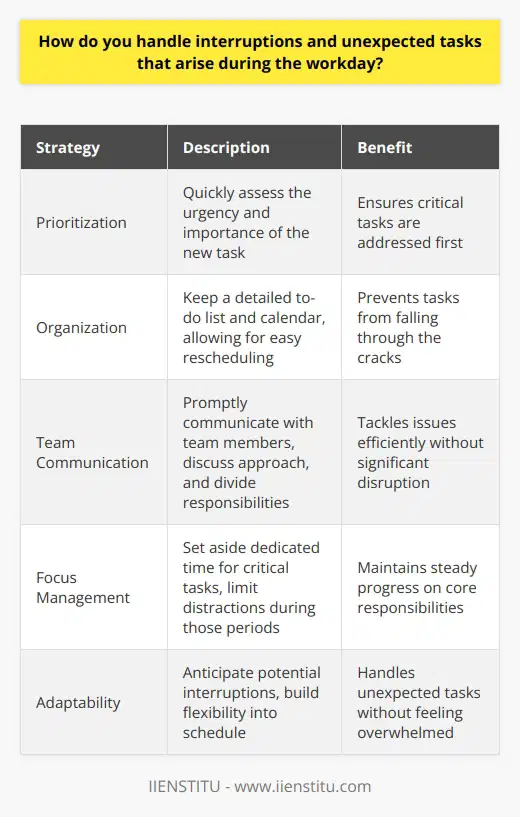
What tools or technology do you use to help you manage your time effectively?
I rely on a combination of digital tools and traditional methods to effectively manage my time. Google Calendar is my go-to for scheduling meetings, deadlines, and appointments. I color-code entries to easily identify priorities at a glance.
Prioritizing Tasks
Each morning, I make a to-do list in my notebook, numbering items based on importance and urgency. Throughout the day, I focus on knocking out the top priorities first. Crossing off completed tasks gives me a real sense of accomplishment and momentum.
Blocking Out Distractions
When I need to concentrate deeply on a project, I use the Pomodoro Technique. I set a timer for 25-minute work sprints, followed by 5-minute breaks. This keeps me focused and prevents mental fatigue. If I'm working on my computer, I'll sometimes use website blockers to eliminate digital distractions during pomodoros.
Automating Repetitive Tasks
For recurring responsibilities, I lean on technology to streamline the process. For instance, I have email templates saved for common types of correspondence. This saves me time from writing the same kinds of messages over and over. I also use IFTTT to automatically backup important files and post to social media on a schedule.
With a mix of digital and analog systems, plus a commitment to focused work blocks, I'm able to stay on top of my tasks and make steady progress on projects. It's an approach that has served me well in both my professional and personal life. Of course, I'm always looking for new tips and tools to be even more efficient!
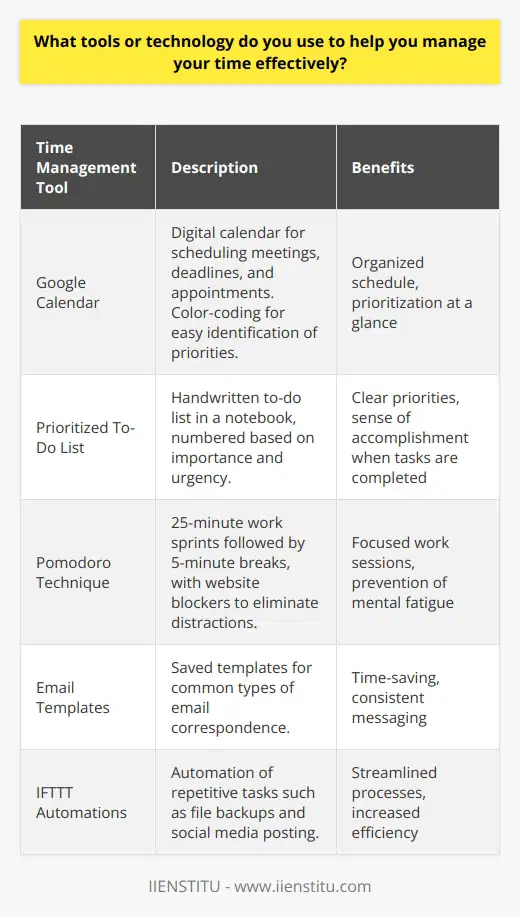
How do you balance your work responsibilities with your personal life?
Balancing work responsibilities and personal life is a crucial skill for maintaining overall well-being and productivity. I make it a priority to establish clear boundaries between my professional and personal time. This involves setting specific hours for work and sticking to them as much as possible.
Effective Time Management
I rely on effective time management strategies to ensure that I can fulfill my work obligations while still having time for personal pursuits. This includes creating detailed to-do lists, prioritizing tasks based on importance and urgency, and breaking larger projects into smaller, manageable steps. By staying organized and focused during work hours, I can maximize my efficiency and minimize the need to bring work home with me.
Open Communication
Open communication with my colleagues and supervisors is another key aspect of maintaining work-life balance. When necessary, I discuss my workload and any challenges I'm facing in meeting deadlines. This allows for collaborative problem-solving and adjustments to be made when needed. Being transparent about my needs and limitations helps prevent work from spilling over into my personal life.
Prioritizing Self-Care
Outside of work, I make a conscious effort to prioritize self-care activities that help me recharge and reduce stress. This includes regular exercise, pursuing hobbies, spending quality time with loved ones, and engaging in relaxation techniques like meditation or deep breathing exercises. By taking care of my physical and mental health, I'm better equipped to handle the demands of both my personal and professional life.
Flexibility and Adaptability
Finally, I recognize that achieving perfect work-life balance isn't always possible, and there will be times when one area requires more attention than the other. In these situations, I remain flexible and adaptable, communicating with my team and loved ones to manage expectations and make necessary adjustments. By approaching work-life balance as an ongoing process rather than a rigid state, I can navigate the challenges and find a sustainable equilibrium that works for me.
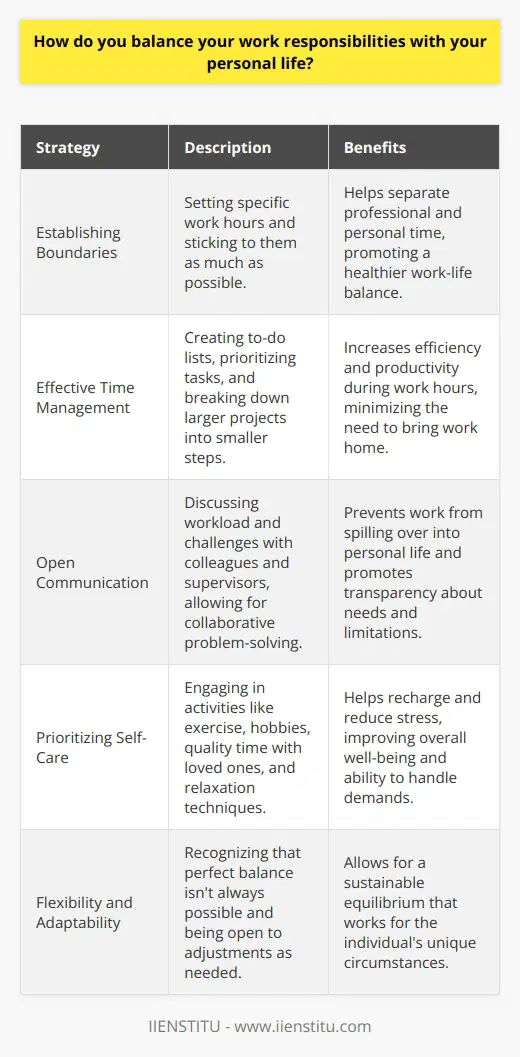
What do you do when you realize that you won't be able to meet a deadline?
When I realize that I won't be able to meet a deadline, the first thing I do is communicate with my team and manager. It's important to be proactive and transparent about the situation.
Assess the Situation
I take a step back and assess why the deadline won't be met. Is it due to unexpected challenges, scope changes, or external factors? Identifying the root cause helps me explain the situation better.
Propose Solutions
After understanding the reasons, I brainstorm possible solutions. Can the scope be adjusted? Can additional resources help? I try to come up with realistic options that can mitigate the impact of the missed deadline.
Communicate Proactively
Armed with the root cause and potential solutions, I reach out to my manager and the stakeholders involved. I explain the situation clearly, taking responsibility for my part. I share my ideas on how we can move forward and make sure everyone is on the same page.
Collaborate and Adjust
I collaborate with my team to adjust our plan based on the agreed-upon solution. We update our timelines, redistribute tasks if needed, and keep everyone informed of the progress. Regular check-ins help ensure we're on track with the revised plan.
Learn and Improve
Once the project is completed, I take time to reflect on the experience. I analyze what could have been done differently to prevent missing the deadline. I learn from my mistakes and identify areas for improvement. This helps me be better prepared for future projects.
In summary, when faced with a potential missed deadline, I assess the situation, propose solutions, communicate proactively, collaborate with my team, and learn from the experience to improve for the future.
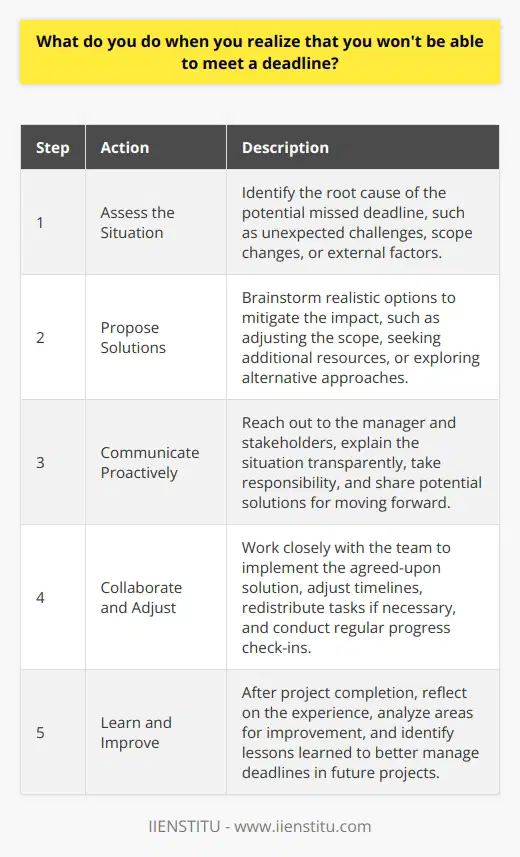
How do you communicate your time constraints to your colleagues and manager?
Communication is key when it comes to managing time constraints and meeting deadlines. I believe in being proactive and transparent with my colleagues and manager about my workload and availability.
Setting Clear Expectations
When I take on a new project or task, I make sure to clarify the timeline and deliverables upfront. This helps me understand what's expected of me and allows me to plan accordingly. If I foresee any potential conflicts or challenges, I bring them up right away so we can find a solution together.
Regular Check-Ins
I find that regular check-ins with my team and manager are crucial for staying on track. During these meetings, I provide updates on my progress, discuss any roadblocks I'm facing, and ask for guidance or support if needed. This keeps everyone in the loop and ensures we're all aligned on priorities.
Prioritizing and Delegating
When my plate starts to get full, I take a step back and assess my priorities. I focus on the most critical and time-sensitive tasks first, and I'm not afraid to ask for help or delegate when necessary. By being honest about my capacity and collaborating with my team, we can find ways to balance the workload and meet our goals.
Leading by Example
As a team player, I strive to lead by example when it comes to communication and time management. I'm always willing to lend a hand to my colleagues and share tips and strategies that have worked well for me. By fostering a culture of openness and support, we can tackle challenges together and achieve great results.
At the end of the day, I believe that effective communication is the foundation of any successful team. By being transparent, proactive, and collaborative, I'm able to manage my time effectively and contribute to the overall success of the company.
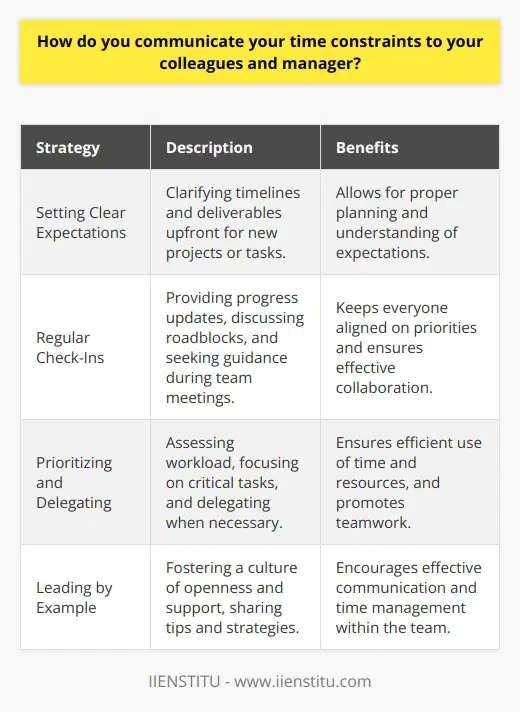
What do you do when you have downtime or less urgent tasks to complete?
When I have downtime or less urgent tasks, I use the opportunity to focus on personal development and growth. This includes taking online courses, reading industry-related articles, and practicing new skills that can benefit my work.
Staying Organized
I also take the time to organize my workspace, update my to-do list, and prioritize upcoming tasks. This helps me stay on top of my responsibilities and maintain a clear mind for tackling future projects.
Collaborating with Colleagues
During downtime, I engage in meaningful conversations with my colleagues. We share ideas, discuss challenges, and brainstorm solutions. These interactions not only strengthen our professional relationships but also foster a collaborative and supportive work environment.
Offering Assistance
If I notice a colleague who could use some help, I offer my assistance. Whether it's proofreading a document, providing feedback on a presentation, or lending a hand with a task, I believe in supporting my team members whenever possible.
Reflection and Evaluation
Lastly, I use downtime to reflect on my performance and identify areas for improvement. I consider the feedback I've received, evaluate my strengths and weaknesses, and set personal goals for growth. This self-reflection allows me to continuously develop as a professional and contribute more effectively to the company's success.

How do you handle procrastination and maintain your motivation to complete tasks?
I tackle procrastination head-on by breaking tasks into smaller, manageable steps. This helps me stay focused and motivated.
Prioritizing Tasks
I prioritize my to-do list based on urgency and importance. This ensures I'm always working on the most critical tasks first.
Setting Realistic Goals
Setting achievable goals is key to maintaining motivation. I challenge myself while keeping expectations realistic to avoid feeling overwhelmed.
Creating a Schedule
I create a daily schedule with dedicated time blocks for each task. This structure keeps me on track and accountable.
Taking Breaks
Regular breaks help me recharge and refocus. I step away from my desk, stretch, and clear my mind.
Personally, I find that a little procrastination can actually boost my creativity. When I'm stuck on a problem, taking a short break to do something enjoyable often leads to a breakthrough. For example, last week I was struggling to come up with a solution for a coding project. After taking a 20-minute walk outside, the answer suddenly came to me!
At the end of the day, staying motivated is about finding what works best for you. Through trial and error, I've discovered techniques that keep me productive and engaged. I'm always looking for ways to improve my workflow and beat procrastination for good.
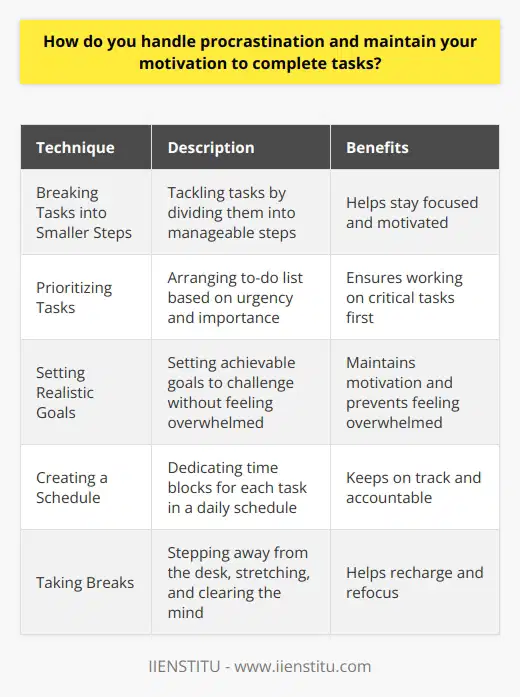
What do you do when you need to work on a task that requires uninterrupted focus?
When I need to work on a task that requires uninterrupted focus, I have a few strategies that help me stay on track and avoid distractions.
Find a Quiet Space
I try to find a quiet, isolated spot where I can work without interruptions. At home, I have a dedicated office nook. At work, I'll book a conference room if needed. Removing myself from noisy, busy areas helps me concentrate.
Put Away Devices
I silence my phone and put it out of sight. I close email and messaging apps on my computer. This prevents me from getting sidetracked by notifications or the urge to check messages. Out of sight, out of mind.
Set a Timer
I'll often set a timer for an hour or two of focused work. Knowing I have a limited window motivates me to make the most of it. I can take a quick break when the timer goes off.
Break Tasks into Steps
Big projects can feel overwhelming. I break them into smaller, manageable steps. Tackling things piece by piece makes it easier to focus and make steady progress. I get a little boost each time I complete a step.
Refuel and Recharge
During breaks, I do things to recharge my brain and body. I'll go for a short walk, have a healthy snack, or do some quick stretches. This helps me return to focused work refreshed and ready to go.
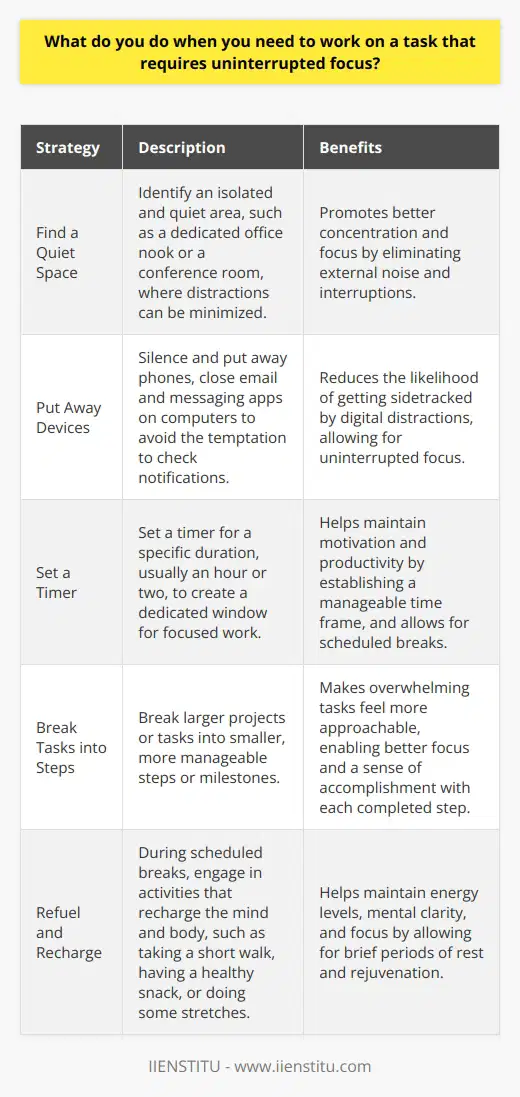
How do you adjust your time management strategies when working on a team project?
When working on a team project, I adjust my time management strategies to ensure successful collaboration and completion. I start by breaking down the project into smaller, manageable tasks and assigning clear deadlines for each one. This helps me and my teammates stay organized and on track.
Prioritizing Communication
I make it a priority to communicate regularly with my team members. We discuss our progress, share ideas, and address any challenges that arise. By staying in close contact, we can quickly identify and resolve any issues that may impact our timeline.
Flexibility is Key
I understand that when working on a team, flexibility is crucial. If a teammate needs assistance or falls behind, I'm always ready to step in and help out. We're all in this together, and sometimes that means adjusting my own schedule to support the team's overall goals.
Adapting to Change
In my experience, projects rarely go exactly as planned. Unexpected obstacles can pop up, or priorities can shift. When this happens, I remain calm and adaptable. I work with my team to reassess our timeline, make necessary adjustments, and find creative solutions to keep us moving forward.
Celebrating Milestones
Finally, I believe in the power of celebrating milestones along the way. When we hit a key target or overcome a significant hurdle, I take a moment to acknowledge the team's hard work and success. This boosts morale and keeps everyone motivated to push through to the end.
At the end of the day, effective time management in a team setting is all about communication, collaboration, and adaptability. By staying connected, supporting one another, and remaining flexible, we can achieve great things together.
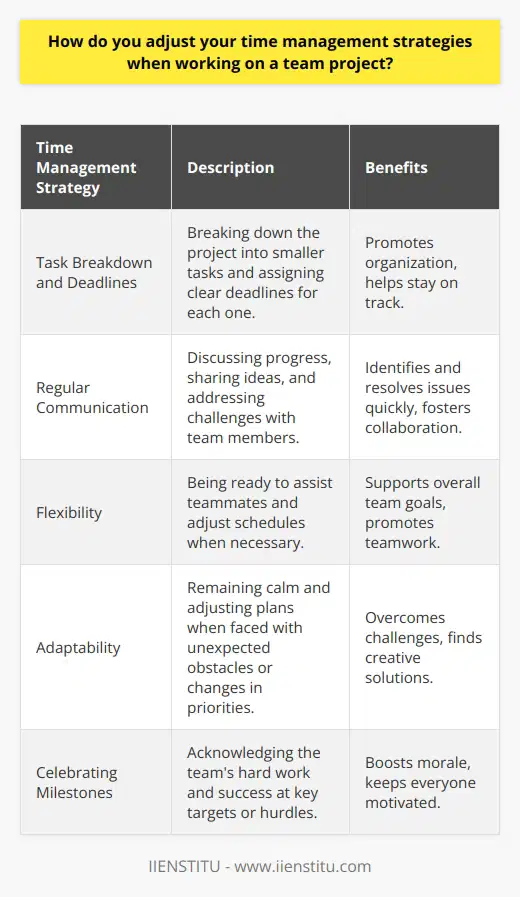
What do you do when you have conflicting priorities from different stakeholders?
When faced with conflicting priorities from different stakeholders, I strive to find a balanced solution. First, I assess the urgency and importance of each request. Then, I communicate openly with all parties involved to understand their needs and constraints. Through active listening and empathy, I aim to find common ground and align expectations.
Prioritizing based on impact
I prioritize tasks that have the greatest positive impact on the company's goals. I consider factors like revenue, customer satisfaction, and team morale. If needed, I escalate issues to my manager for guidance on the best course of action.
Transparent communication is key
Throughout the process, I keep stakeholders informed about progress and any changes in timelines. I've found that proactive updates help build trust and understanding. Even if I can't fully meet everyone's demands, they appreciate being kept in the loop.
Collaborative problem-solving
Whenever possible, I bring stakeholders together to brainstorm win-win solutions. By tapping into the group's collective knowledge, we often discover innovative approaches. These sessions foster teamwork and help prevent future conflicts by aligning everyone around shared objectives from the start.
In my experience, handling conflicting priorities requires a blend of tactful communication, creative problem-solving, and strong decision-making skills. It's a challenging part of the job, but also an opportunity to demonstrate leadership and deliver meaningful results.
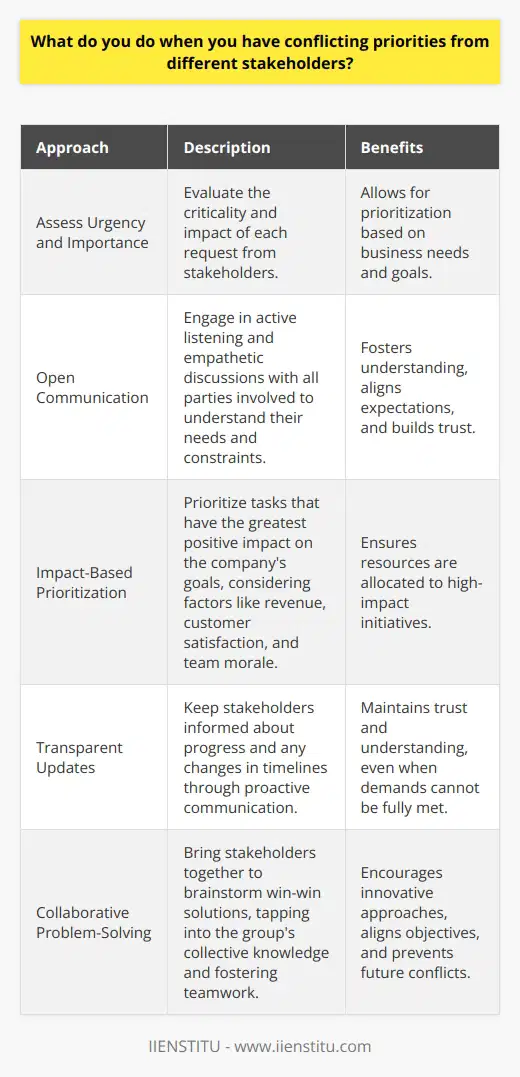
How do you ensure that you are taking breaks and avoiding burnout?
I believe that taking regular breaks is essential for maintaining productivity and avoiding burnout. I make sure to step away from my desk every hour or so, even if it's just for a few minutes. During these breaks, I like to stretch, take a short walk, or do some deep breathing exercises.
Scheduling Breaks
To ensure that I don't forget to take breaks, I schedule them into my calendar. I treat them as important appointments that I can't miss. This helps me prioritize my well-being and prevents me from getting too caught up in my work.
Hobbies and Interests
Outside of work, I have several hobbies that help me unwind and recharge. I enjoy painting, hiking, and playing the guitar. Engaging in these activities allows me to disconnect from work and focus on something I enjoy. It's important to have a life outside of work to maintain a healthy work-life balance.
Recognizing Signs of Burnout
I've learned to recognize the signs of burnout in myself, such as feeling exhausted, irritable, or disengaged. When I notice these signs, I know it's time to take a step back and prioritize self-care. This might mean taking a mental health day, delegating tasks, or seeking support from colleagues or a supervisor.
Communication is Key
I believe that open communication is crucial for avoiding burnout. If I'm feeling overwhelmed or struggling with my workload, I make sure to speak up and ask for help. I've found that my colleagues and supervisors are usually more than willing to support me when I'm honest about my needs.
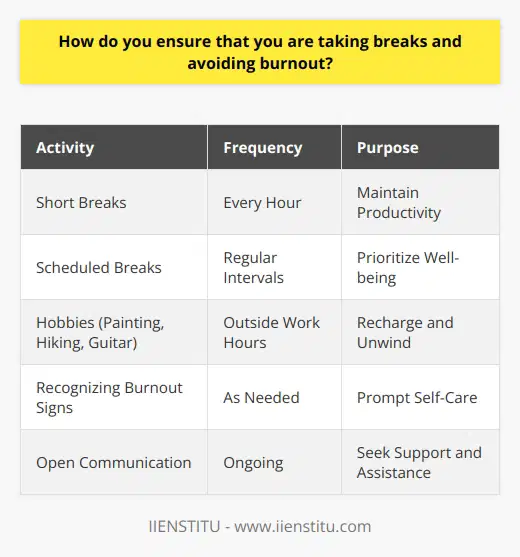
What do you do when you need to learn a new skill or tool to complete a task?
When I need to learn a new skill or tool to complete a task, I dive right in. I'm always eager to expand my knowledge and take on new challenges. First, I assess the resources available to me, such as online tutorials, documentation, or colleagues with expertise. I set aside dedicated time to focus on learning, breaking it down into manageable chunks.
Hands-On Practice Is Key
I believe the best way to truly grasp a new skill is through hands-on experience. I'm not afraid to get my hands dirty and start experimenting with the tool or practicing the skill. Trial and error is part of my learning process. I tinker, make mistakes, and learn from them. It's how I cement my understanding and gain confidence.
Collaborating and Seeking Guidance
I'm not shy about reaching out to others for guidance when I'm learning something new. I tap into the knowledge of my colleagues, mentors, or online communities. Collaborating with others allows me to learn from their experiences, ask questions, and get feedback. I find that discussing ideas and concepts with others deepens my comprehension.
Applying What I Learn
To reinforce my newly acquired skills, I look for opportunities to apply them in real-world scenarios. I volunteer for projects or tasks that allow me to practice and refine my abilities. I believe that the best way to master a skill is by putting it into action and learning from practical experience.
Throughout my learning journey, I remain patient and persistent. I understand that acquiring new skills takes time and effort. I celebrate my progress, no matter how small, and use setbacks as opportunities for growth. With dedication and a positive attitude, I'm confident in my ability to learn any skill necessary to excel in my role.
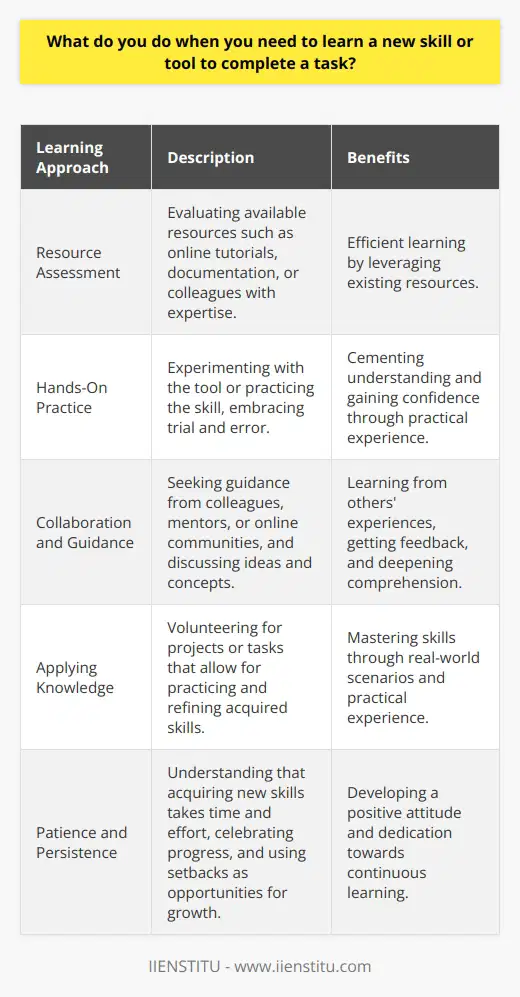
How do you handle tasks that are outside of your job description or comfort zone?
When faced with tasks outside my job description or comfort zone, I view them as opportunities for growth. I embrace challenges and approach them with a positive attitude, knowing that stepping outside my comfort zone is necessary for personal and professional development.
Communicate and Seek Guidance
If I'm unsure about how to handle a task, I don't hesitate to ask questions. I reach out to my supervisor or colleagues who have more experience in that area. By seeking guidance, I can gain a better understanding of what needs to be done and how to approach it effectively.
Break It Down
When faced with a complex or unfamiliar task, I break it down into smaller, manageable steps. This helps me focus on one aspect at a time and prevents me from feeling overwhelmed. I prioritize the most critical components and work my way through the task systematically.
Leverage Available Resources
I make use of the resources available to me, whether it's online tutorials, training materials, or expert advice. By leveraging these resources, I can quickly acquire the knowledge and skills needed to tackle the task at hand. I'm not afraid to invest time in learning something new if it means delivering better results.
Embrace the Learning Curve
I understand that taking on tasks outside my comfort zone often involves a learning curve. I approach these situations with patience and persistence. I know that with time and practice, I'll become more proficient and confident in handling such tasks. I view each challenge as an opportunity to expand my skill set and become a more versatile professional.
In summary, when faced with tasks outside my job description or comfort zone, I communicate openly, break them down into manageable steps, leverage available resources, and embrace the learning curve. By approaching these situations with a growth mindset and a willingness to learn, I can successfully navigate unfamiliar territory and deliver results that exceed expectations.
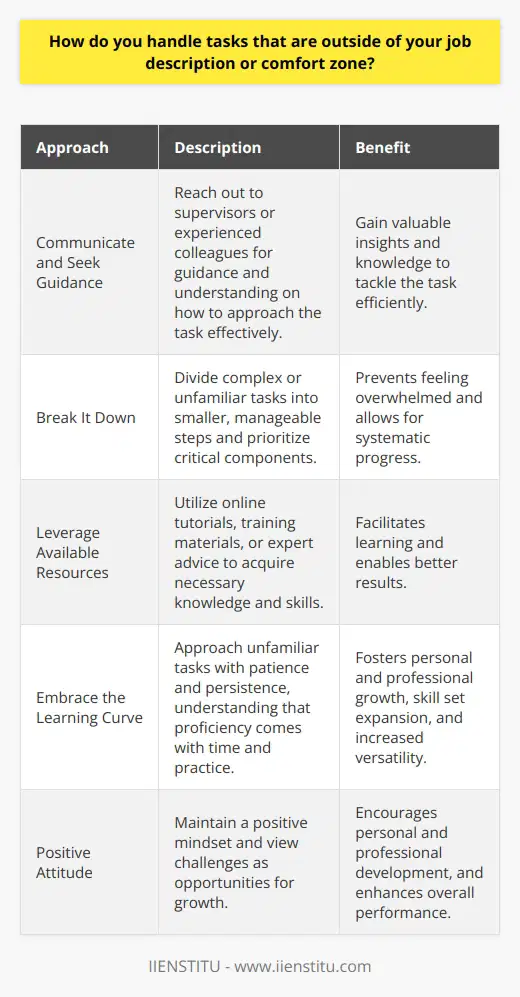
What do you do when you need to delegate tasks to others to manage your workload?
When my workload becomes overwhelming, I take a step back and assess which tasks can be delegated effectively. I consider the skills and availability of my team members to determine who is best suited for each task.
Communicating Clear Expectations
I ensure that I communicate my expectations clearly when delegating tasks. I provide detailed instructions and any necessary resources to set my team up for success. I also make myself available to answer questions and provide guidance throughout the process.
Trusting My Team
One of the most important aspects of successful delegation is trust. I have confidence in my team's abilities and trust them to complete the tasks I assign. This empowers them to take ownership of their work and allows me to focus on higher-level responsibilities.
Following Up and Providing Feedback
After delegating tasks, I make sure to follow up regularly to monitor progress and offer support when needed. Once the tasks are completed, I provide constructive feedback to help my team members grow and improve. I also make sure to recognize and appreciate their efforts and contributions.
By delegating tasks effectively, I can manage my workload more efficiently while also providing opportunities for my team to develop their skills and take on more responsibility.
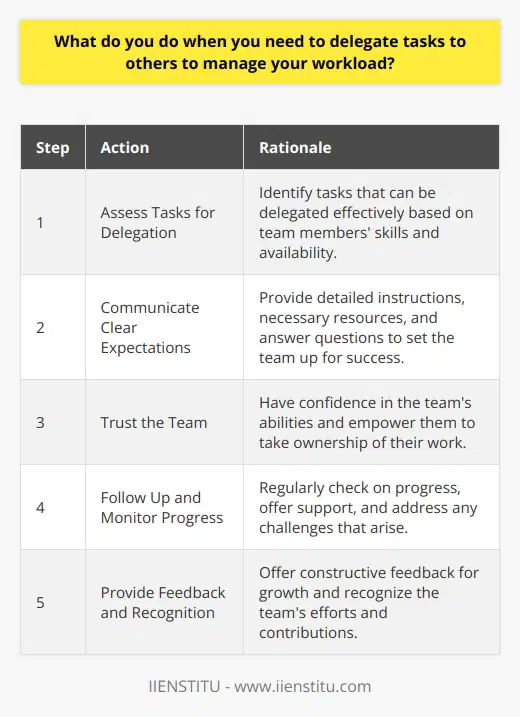
How do you ensure that you are meeting your long-term goals while managing your daily tasks?
I ensure that I'm meeting my long-term goals while managing my daily tasks through a combination of careful planning, prioritization, and regular review. Here's how I approach it:
Set clear long-term goals
I take time to define my long-term objectives, both professionally and personally. Having a clear vision of where I want to be helps guide my daily actions. For example, when I was working towards my Project Management Professional certification, I broke down the requirements into manageable milestones.
Break goals into actionable steps
I translate my big-picture goals into specific, achievable tasks. I ask myself, "What do I need to accomplish this month, this week, today, to move closer to my target?" Breaking it down makes it feel doable rather than overwhelming.
Prioritize ruthlessly
With my to-do list in hand, I prioritize based on importance and urgency. I tackle the most critical items first, even if they're not the most pleasant. The Eisenhower Matrix has been a helpful tool for sorting out my priorities.
Schedule regular check-ins
I block out time each week to review my progress. Am I on track? Do I need to adjust my daily tasks to realign with my goals? These frequent check-ins help me course-correct before I veer too far off the path.
Stay flexible
Life happens, and sometimes I need to adapt. If an unexpected project lands on my desk, I reassess my priorities and reshuffle as needed. The key is to stay focused on the end goal, even if the route there shifts a bit.
By following this approach, I've been able to make steady progress on my long-term goals while still handling the day-to-day demands of my role. It takes discipline and planning, but the payoff is worth it.
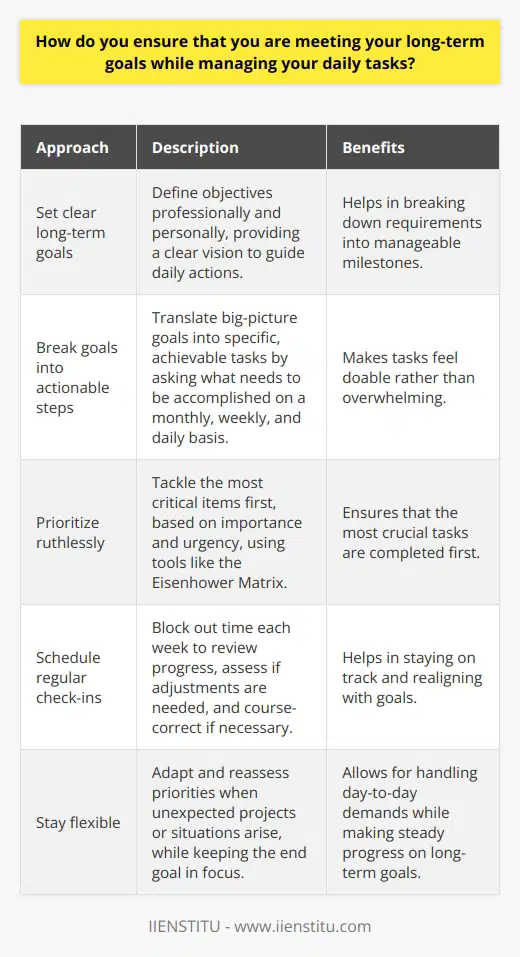
What do you do when you need to work overtime to meet a deadline?
When faced with a tight deadline that requires overtime, I take a proactive and organized approach. First, I prioritize my tasks and create a detailed plan to ensure I'm using my time efficiently. Communication is key, so I keep my team and supervisors informed about my progress and any challenges I encounter.
Staying Focused and Motivated
To maintain my focus during extended work hours, I take short breaks to recharge and avoid burnout. I find that setting small milestones helps me stay motivated and gives me a sense of accomplishment along the way. I also make sure to maintain a healthy work-life balance by taking care of myself outside of work, like getting enough sleep and exercise.
Collaborating with the Team
When working overtime, collaboration becomes even more crucial. I actively seek out opportunities to delegate tasks and work with my colleagues to share the workload. By leveraging the strengths of my team members, we can tackle the deadline more efficiently and effectively.
Learning from the Experience
After successfully meeting a deadline through overtime, I always take the time to reflect on the experience. I analyze what worked well and identify areas for improvement. This helps me continuously refine my time management skills and be better prepared for future challenges.
In summary, when overtime is necessary to meet a deadline, I approach it with a positive attitude, a well-structured plan, and a focus on collaboration. By staying organized, communicating effectively, and taking care of myself, I'm able to deliver high-quality work while managing the stress of extended hours.
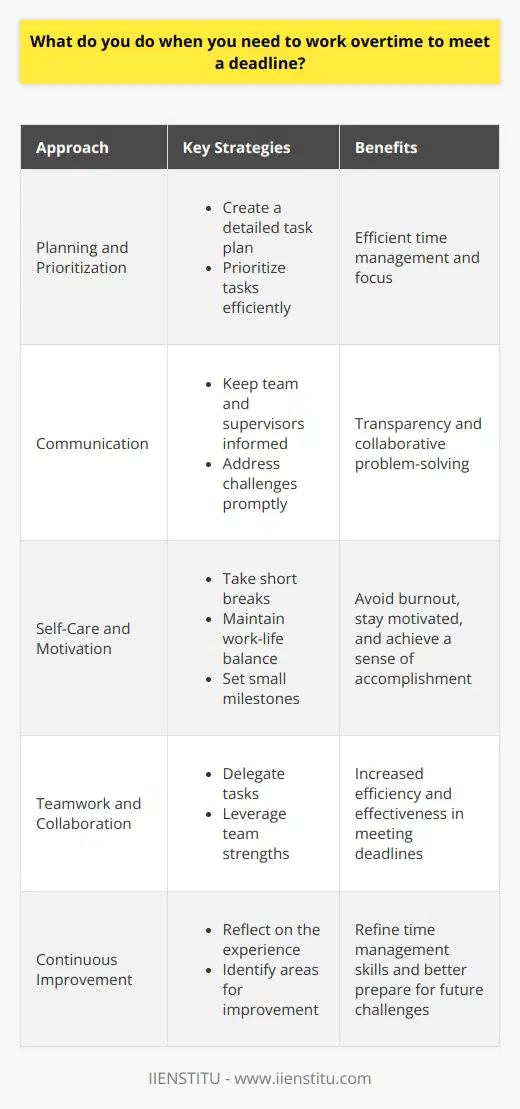
How do you handle tasks that require collaboration with remote team members?
I have extensive experience collaborating with remote team members to successfully complete projects. Here are some strategies I employ:
Establish Clear Communication Channels
I believe in setting up regular check-ins and using tools like Slack or Zoom to stay connected. This helps ensure everyone is on the same page and can quickly address any issues that arise.
Leverage Project Management Software
Utilizing platforms like Asana or Trello allows remote teams to track progress, assign tasks, and meet deadlines. I find these invaluable for keeping projects organized and moving forward smoothly.
Foster a Collaborative Culture
I strive to create an inclusive environment where all team members feel heard and valued. Encouraging open communication, actively seeking input, and recognizing contributions goes a long way in building strong remote partnerships.
Adapt to Different Time Zones and Schedules
When working across time zones, I'm flexible and willing to occasionally adjust my hours for better collaboration. Planning ahead and clearly communicating availability is key to overcoming scheduling challenges.
Prioritize Face-to-Face Interaction When Possible
While not always feasible, I find that periodic in-person meetings, even if just once a year, significantly strengthen remote team bonds and cohesion. There's no true substitute for face-to-face interaction!
At the end of the day, successful remote collaboration comes down to clear communication, mutual respect, and a shared commitment to achieving goals. I'm confident my skills and approach would allow me to thrive in this role.
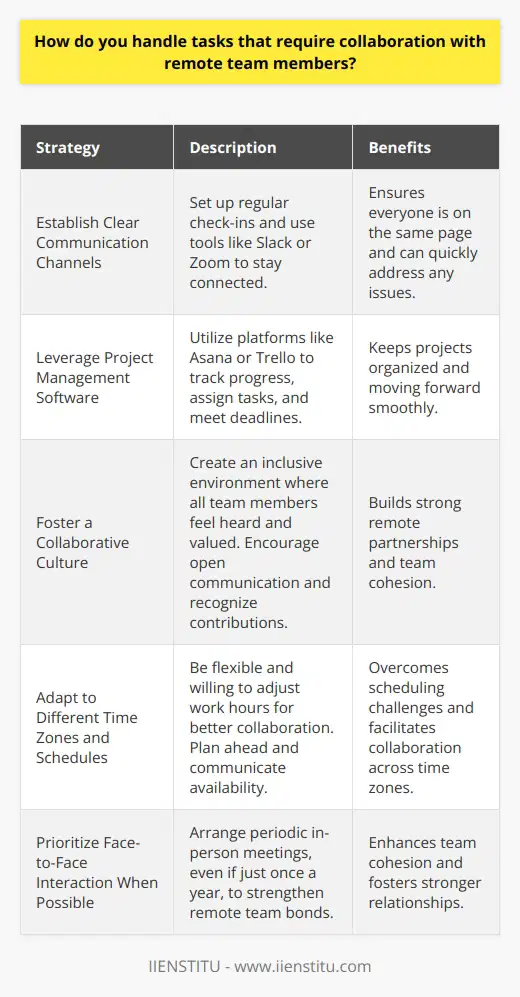
What do you do when you need to balance your work responsibilities with your personal commitments?
When balancing work responsibilities with personal commitments, effective time management and open communication are key. I prioritize tasks based on urgency and importance, ensuring that critical work deadlines are met while still making time for personal obligations. This may involve creating a detailed schedule, breaking larger projects into smaller, manageable steps, and being flexible when unexpected situations arise.
Setting Clear Boundaries
I believe in setting clear boundaries between work and personal life. When I'm at work, I focus on my professional duties, and when I'm off the clock, I dedicate my time to family, friends, and personal interests. This helps me maintain a healthy work-life balance and prevents burnout.
Open Communication
If there are times when personal commitments may impact my work schedule, I proactively communicate with my supervisor and colleagues. By being transparent and proposing solutions, such as adjusting my work hours or collaborating with team members, I can often find a mutually beneficial arrangement that allows me to meet both my professional and personal responsibilities.
Flexibility and Adaptability
Life can be unpredictable, and I understand that there may be occasions when unexpected personal situations require my attention. In these cases, I try to be flexible and adaptable, finding creative ways to manage my workload while still being present for my loved ones. This might involve working remotely, delegating tasks, or making up work hours at a later time.
Continuous Self-Improvement
I'm always looking for ways to improve my time management skills and efficiency. I attend workshops, read books, and seek advice from mentors to learn new strategies for balancing work and personal life. By continuously learning and growing, I can better navigate the challenges of juggling multiple responsibilities.
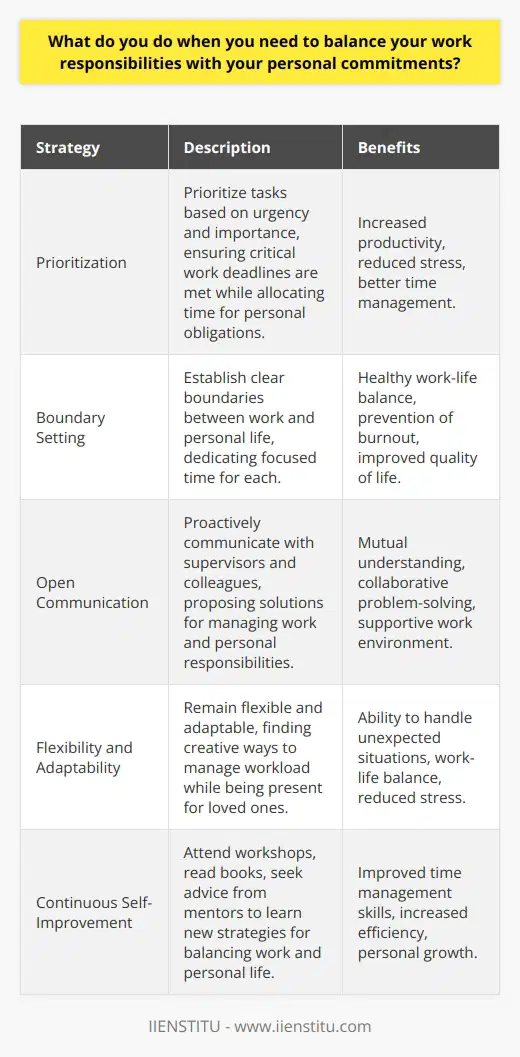
How do you handle tasks that require you to be creative and think outside the box?
When faced with tasks that require creativity and out-of-the-box thinking, I embrace the challenge with enthusiasm. I've always been a curious person, constantly asking questions and seeking new perspectives. This natural curiosity fuels my ability to approach problems from unique angles.
Drawing Inspiration from Diverse Sources
To spark my creativity, I draw inspiration from a wide range of sources. I love exploring art, music, and literature, as they often provide fresh ideas and unconventional connections. Engaging with diverse content helps me break free from conventional thinking patterns.
Collaborating with Others
I firmly believe that collaboration is key to fostering creativity. When working on a team, I actively listen to my colleagues' ideas and build upon them. The synergy that comes from diverse minds working together often leads to breakthrough solutions.
Embracing Failure as a Learning Opportunity
I understand that creative thinking involves taking risks and embracing the possibility of failure. Rather than being discouraged by setbacks, I view them as valuable learning experiences. Each failure brings me closer to finding an innovative solution.
Staying Open-Minded and Adaptable
To think outside the box, I maintain an open mind and remain adaptable. I'm always willing to consider alternative approaches and adapt my strategies when necessary. By staying flexible, I can navigate complex challenges and find creative solutions.
In my previous role, I was tasked with developing a new marketing campaign for a struggling product line. Instead of relying on traditional methods, I conducted extensive market research, seeking insights from unconventional sources. By collaborating with a diverse team and embracing bold ideas, we created a campaign that resonated with our target audience, leading to a significant increase in sales.
Ultimately, I believe that creativity thrives when we embrace our curiosity, collaborate with others, learn from failures, and stay open-minded. By applying these principles, I am confident in my ability to tackle tasks that require innovative thinking and deliver outstanding results.
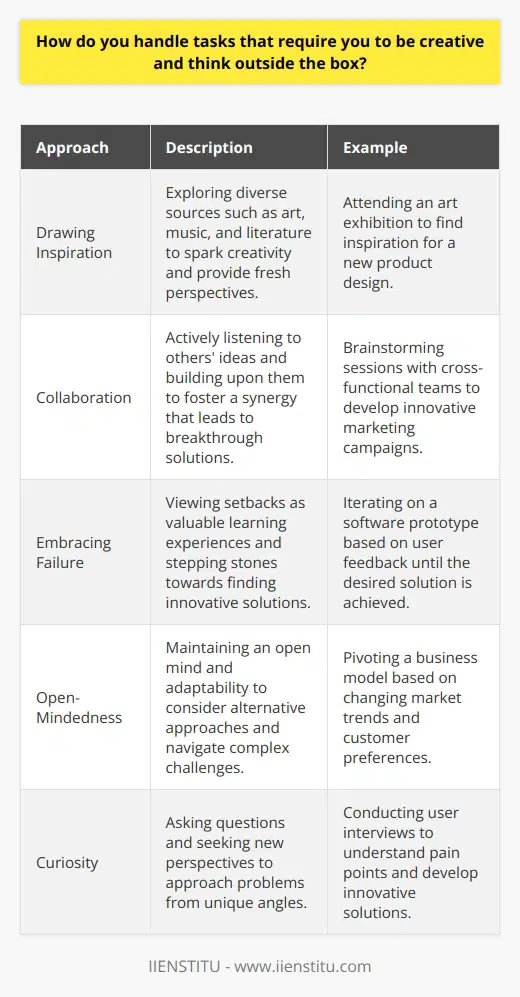
What do you do when you need to work on a task that you find boring or uninspiring?
When faced with a boring or uninspiring task, I first try to understand its importance and purpose. Even mundane tasks contribute to the bigger picture, so I focus on the end goal to stay motivated.
Breaking It Down
I break the task into smaller, manageable steps. This makes it feel less overwhelming and helps me progress steadily. I set mini-deadlines for each step to keep myself accountable and on track.
Finding Ways to Engage
I look for ways to make the task more engaging or challenging. Can I use a new tool or approach? Is there a way to be more efficient or creative? Experimenting keeps things interesting.
Rewarding Myself
I promise myself a small reward for completing the task, like a coffee break or checking something fun online. Having something to look forward to helps me push through the boring parts.
Seeking Inspiration
If I'm really struggling, I'll take a quick break to find inspiration. I might browse industry blogs, chat with a colleague, or listen to an upbeat song – whatever gives me a motivational boost.
At the end of the day, I know that powering through uninspiring tasks is just part of the job. But by staying focused on the purpose, breaking things down, and finding ways to engage, I'm always able to get the work done well.
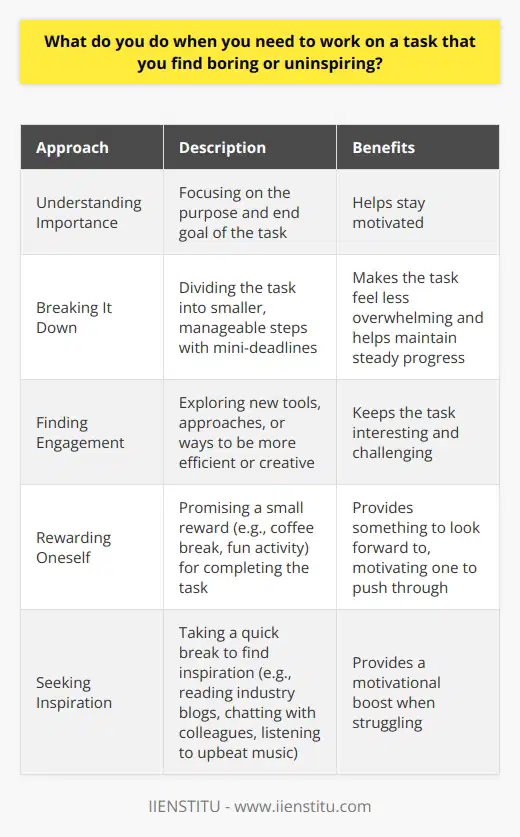
How do you ensure that you are staying organized and keeping track of your progress?
I've developed a reliable system to stay organized and track my progress effectively. It involves a combination of digital tools and traditional methods that keep me on top of my tasks and goals.
Prioritizing Tasks
I start each day by reviewing my to-do list and prioritizing the most important and urgent tasks. This helps me focus my energy on what matters most and ensures I'm making steady progress toward my objectives.
Breaking Down Projects
When tackling larger projects, I break them down into smaller, manageable steps. This makes the overall task less daunting and allows me to track my progress more easily. I set milestones along the way to keep myself motivated and on schedule.
Using Digital Tools
I rely on digital tools like project management software and calendar apps to stay organized. These tools allow me to set reminders, collaborate with others, and access my information from anywhere. I find that having a centralized hub for all my tasks and deadlines is incredibly helpful.
Regularly Reviewing Progress
I make it a habit to review my progress on a regular basis, usually at the end of each week. This gives me a chance to celebrate my accomplishments, identify areas for improvement, and adjust my plans if needed. It's a great way to stay accountable and ensure I'm always moving forward.
Staying Flexible
While having a solid organizational system is important, I also believe in staying flexible. Life can be unpredictable, and I've learned to adapt my plans when necessary. Being able to pivot and adjust my approach has helped me stay on track even when faced with unexpected challenges.
By combining these strategies, I've been able to consistently stay organized and make steady progress toward my goals. It's a system that has served me well in both my personal and professional life.
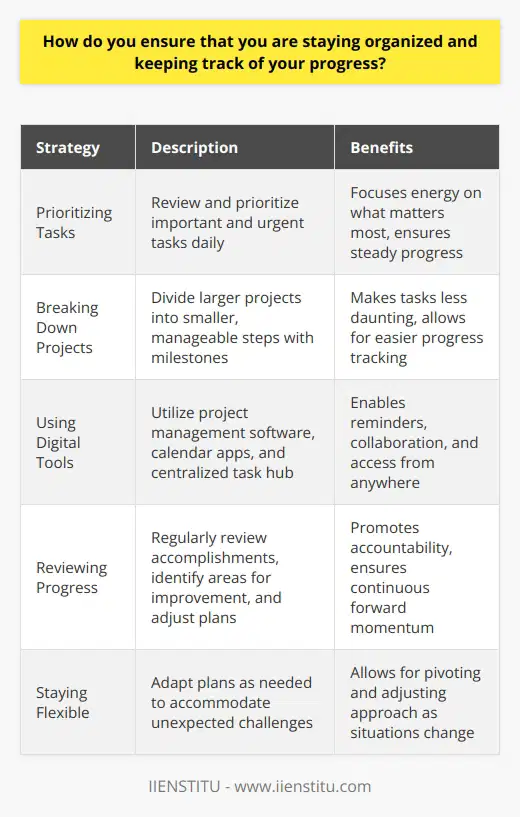
What do you do when you need to work on a task that requires a high level of attention to detail?
When I need to work on a task that requires a high level of attention to detail, I take several steps to ensure accuracy and thoroughness.
Create a Distraction-Free Environment
I find a quiet space where I can focus solely on the task at hand. I silence my phone, close unnecessary browser tabs, and minimize any potential interruptions. This allows me to fully immerse myself in the work and pay close attention to every aspect of the project.
Break the Task into Manageable Steps
I break down the task into smaller, manageable steps. This helps me to stay organized and ensures that I don't overlook any important details. I create a checklist of each step and methodically work through it, double-checking my work as I go.
Take Regular Breaks
I've learned that taking short breaks can actually improve my attention to detail. Stepping away from the task for a few minutes helps me to refocus and approach the work with fresh eyes. I might take a quick walk, stretch, or simply close my eyes and take a few deep breaths.
Collaborate with Others
When possible, I collaborate with colleagues or team members. Having another set of eyes review my work can help catch any errors or inconsistencies I may have missed. I'm always open to feedback and suggestions, as it ultimately leads to a better final product.
By implementing these strategies, I'm able to maintain a high level of attention to detail and produce work that meets or exceeds expectations. Attention to detail is a skill I've honed over time, and I take pride in delivering accurate and thorough results.
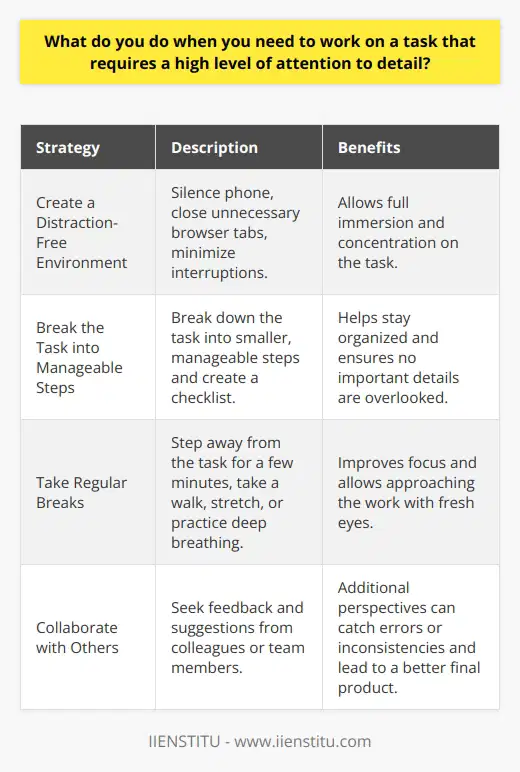
How do you handle tasks that require you to be flexible and adapt to changing circumstances?
Throughout my career, I've learned that flexibility and adaptability are essential skills in today's fast-paced work environment. When faced with tasks that require me to pivot and adjust to changing circumstances, I embrace the challenge as an opportunity for growth and innovation.
Staying Calm and Focused
The first step in handling these situations is to remain calm and focused. I take a moment to assess the new information or requirements and determine how they impact the task at hand. By maintaining a clear head, I can make rational decisions and prioritize effectively.
Communicating with the Team
Next, I believe in the power of open communication. I reach out to my team members and stakeholders to discuss the changes and gather their insights. Collaborating with others helps me gain a broader perspective and generates creative solutions to address the new challenges.
Embracing a Positive Mindset
Throughout the process, I maintain a positive mindset. I view change as an opportunity to learn, grow, and discover new ways of approaching problems. This attitude keeps me motivated and encourages my team to stay engaged and productive, even in the face of uncertainty.
Adapting Strategies and Techniques
Finally, I'm not afraid to adapt my strategies and techniques to suit the new circumstances. I draw upon my past experiences and knowledge to find alternative approaches that can help me achieve the desired outcomes. I'm also open to learning new skills and tools that can enhance my ability to navigate change effectively.
In summary, when faced with tasks that require flexibility and adaptability, I stay calm, communicate openly, embrace a positive mindset, and adapt my strategies to ensure success. These experiences have not only helped me grow professionally but have also made me a more resilient and valuable team member.
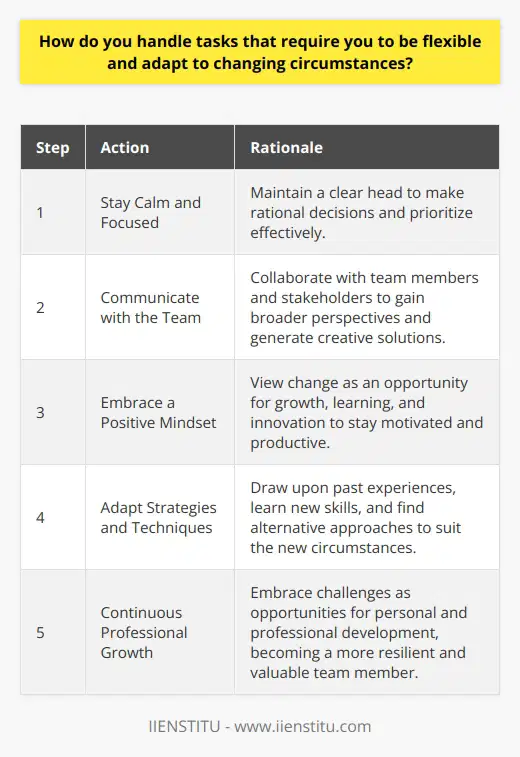
What do you do when you need to balance your individual tasks with your team responsibilities?
When balancing individual tasks with team responsibilities, I prioritize open communication and collaboration. I discuss my workload with my team and manager to ensure we're all aligned on priorities and deadlines.
Proactively Communicate
If I'm feeling overwhelmed or spot a potential conflict between my individual work and team deliverables, I speak up. Hiding issues only makes them worse. I'd rather loop in my team early so we can figure out solutions together.
Lend a Helping Hand
While focusing on my own tasks is important, I'm always happy to help a teammate in need. Just last month, I took some work off my colleague Sara's plate when she had a family emergency. Pitching in builds trust and goodwill.
Advocate for Myself
At the same time, I'm not afraid to say no when I truly don't have the bandwidth. Overcommitting helps no one. If I'm drowning in critical solo work, I'll explain the situation to my team. Together, we reassess priorities and reshuffle tasks if needed.
In my experience, balancing individual and team responsibilities comes down to transparency, collaboration, and knowing your limits. I aim to be a team player while still advocating for myself and what I need to succeed in my role.
